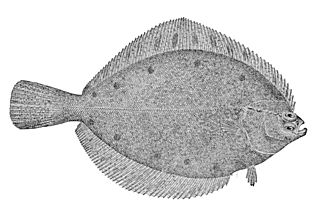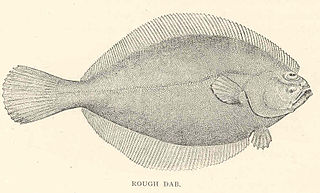
A flatfish is a member of the ray-finned demersal fish order Pleuronectiformes, also called the Heterosomata, sometimes classified as a suborder of Perciformes. In many species, both eyes lie on one side of the head, one or the other migrating through or around the head during development. Some species face their left sides upward, some face their right sides upward, and others face either side upward.

Pleuronectidae, also known as righteye flounders, are a family of flounders. They are called "righteye flounders" because most species lie on the sea bottom on their left sides, with both eyes on their right sides. The Paralichthyidae are the opposite, with their eyes on the left side. A small number of species in Pleuronectidae can also have their eyes on the left side, notably the members of the genus Platichthys.

The European plaice, commonly referred to as simply plaice, is a species of marine flatfish in the genus Pleuronectes of the family Pleuronectidae.

The common dab is an edible flatfish of the family Pleuronectidae. It is a demersal fish native to shallow seas around Northern Europe, in particular the North Sea, where it lives on sandy bottoms down to depths of about 100 metres (330 ft). It can reach 40 centimetres (16 in) in length and can weigh up to 1 kilogram (2.2 lb), though most specimens grow no longer than 20 centimetres (7.9 in).

The American plaice, American sole or long rough dab is a North Atlantic flatfish that belongs, along with other right-eyed flounders, to the family Pleuronectidae. In the northwest Atlantic it ranges from Greenland and Labrador to Rhode Island, and in the northeast Atlantic it ranges from Murmansk to the English Channel, Ireland and Iceland. They live on soft bottoms at depths of 10 to 3,000 m (33–9,843 ft), but mainly between 90 and 250 m (300–820 ft).

Alaska plaice is a saltwater fish that live in the North Pacific Ocean. Alaska plaice are right-eye flounders which live on the sandy bottoms of the continental shelf, up to 600 metres deep. Their geographic range is from the Gulf of Alaska in the east, to the Chukchi Sea in the north, to the Sea of Japan in the west. Alaska plaice feed mostly on polychaetes, but also eat amphipods and echiurans.

The European flounder is a flatfish of European coastal waters from the White Sea in the north to the Mediterranean and the Black Sea in the south. It has been introduced into the United States and Canada accidentally through transport in ballast water. It is caught and used for human consumption.

Hippoglossoides is a genus of righteye flounders native to the North Pacific and North Atlantic oceans.

Plaice is a common name for a group of flatfish that comprises four species: the European, American, Alaskan and scale-eye plaice.

Cynoglossus quadrilineatus, the fourlined tonguesole, is a species of tonguefish native to the Indian Ocean from Pakistan to the western Pacific Ocean where it occurs from Japan to northern Australia. It can be found in marine and brackish waters in estuaries and coastal waters out to the continental shelf at depths of from 10 to 400 metres. This species can reach a length of 44 centimetres (17 in) SL though most do not exceed 30 centimetres (12 in) SL. It is important in local commercial fisheries.
In the 10th edition of Systema Naturae, Carl Linnaeus described the Pisces as:
Always inhabiting the waters; are swift in their motion and voracious in their appetites. They breathe by means of gills, which are generally united by a bony arch; swim by means of radiate fins, and are mostly covered over with cartilaginous scales. Besides the parts they have in common with other animals, they are furnished with a nictitant membrane, and most of them with a swim-bladder, by the contraction or dilatation of which, they can raise or sink themselves in their element at pleasure.

Synaptura is a genus of soles. Most species are found in salt and brackish water in the Indo-Pacific and tropical East Atlantic, but S. salinarum is restricted to fresh water in Australia. The largest species in the genus reaches a length of 50 cm (20 in).
Aega antarctica is a species of isopod crustacean. It is a temporary ectoparasite of fish, feeding on the fish's blood and then dropping to the seabed to digest its meal over a period of several months. It is found in the seas around Antarctica.

Lepeophtheirus pectoralis is a species of parasitic copepod from the northeast Atlantic Ocean, and the type species of the genus Lepeophtheirus. It is a parasite of flatfish, with the European flounder, the plaice, and the dab as the most frequent hosts. It feeds on the mucus, skin, and blood of the fish, with egg-producing females infecting the pectoral and pelvic fins of the host, while immature individuals and males are found on the rest of the body.

Amusium is a genus of scallops, marine bivalve molluscs belonging to the family Pectinidae.

Dorothy Elizabeth Thursby-Pelham (1884–1972) was a scientist at the Zoological Laboratory, University of Cambridge and subsequently at the Ministry of Agriculture, Fisheries and Food - Directorate of Fisheries laboratory in Lowestoft who has been called 'England's first female sea-going fisheries scientist' and was an active member of the International Council for the Exploration of the Sea (ICES).

The Turbot Bank is a shelf bank and mound feature of the seabed of the North Sea that lies off the east coast of Scotland, about 44 kilometres (27 mi) east of Peterhead. The depth of water above the bank varies from 60 m below sea level on top of the bank down to 80 m at its margins. It has been designated as a Nature Conservation Marine Protected Area since 2014.

Pontobdella muricata is a species of marine leech in the family Piscicolidae. It is a parasite of fishes and is native to the northeastern Atlantic Ocean, the Baltic Sea, the North Sea, and the Mediterranean Sea.
Richard JohnPentreath is a British marine scientist who made major contributions to radioecology, particularly with regard to alpha-emitting nuclides in the marine environment. He went on to broaden the international system of radiological protection to include animals and plants with respect to different exposure situations, as well as protection of the animal as patient in veterinary medicine. He also played a major role in the success of the National Rivers Authority and its subsequent merging with other bodies to form the Environment Agency.













